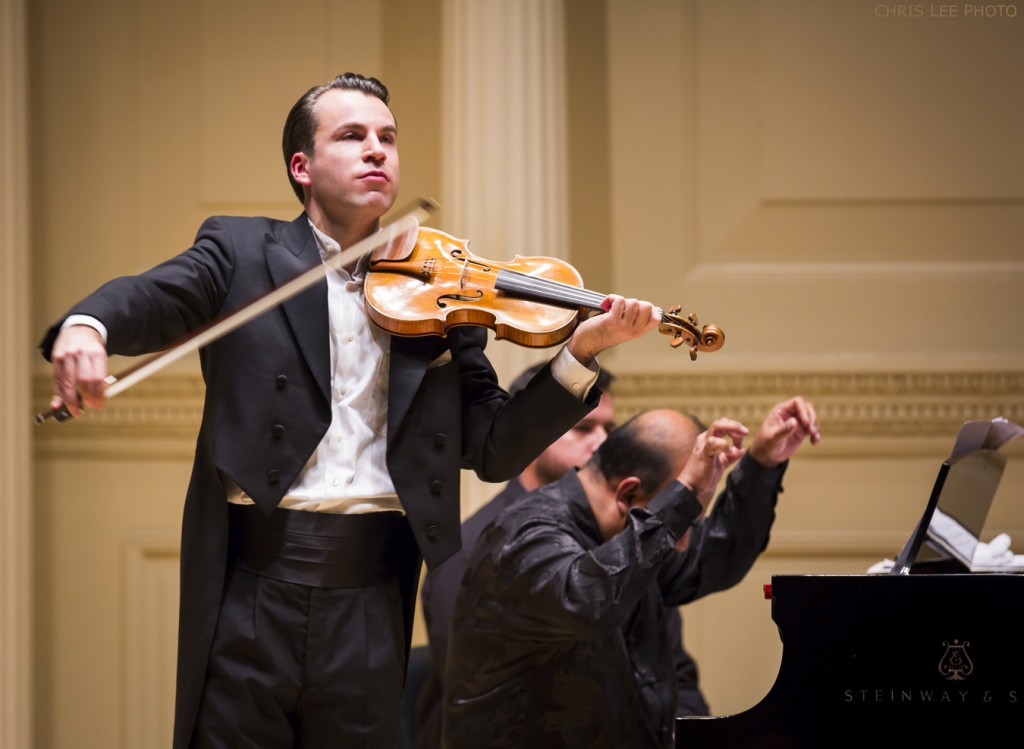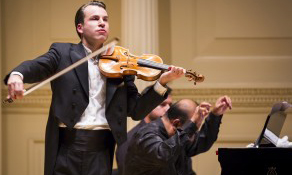Violinist Daniel Röhn in Review
Daniel Röhn in Recital: The Kreisler Story
Weill Recital Hall at Carnegie Hall, New York, N.Y.
February 2, 2016
It is a rare recital that leaves one wanting to hear it all again the next day, but it is not an exaggeration to say that I wanted exactly that after hearing the recent New York recital of German violinist Daniel Röhn. In collaboration with pianist Rohan de Silva and in birthday tribute to the great Austrian composer-violinist Fritz Kreisler, Mr. Röhn combined technical wizardry, melting musicality, old-world style and panache, and a fair amount of historic edification in his comments, all woven seamlessly together into an utterly perfect evening.
Lest it appear that I have some bias towards this frothy fare, that is not the case, for many of these works I’ve heard quite often (or played as collaborator) without their holding nearly so much attraction; what was so captivating was Daniel Röhn’s easy and elegant mastery, always with beauty of sound, purity of intonation, and elasticity of phrase. It was a wonder to behold and reaffirmed the grandeur of the “Golden Age of the Violin” of the 1920’s and 1930’s.

Daniel Röhnm accompanied by pianist Rohan De Silva at Weill Recital Hall, 2/2/16. Photo by Chris Lee
Boldly and with a regal pacing Mr. Röhn opened with Kreisler’s oft-played Praeludium and Allegro, an assertive beginning. He followed it with the equally beloved Bach-Kreisler Gavotte from the E Major Partita BWV 1006, played with polish and sensitivity. Some offhand remarks put an awestruck audience at ease to enjoy the lyrical Paganini-Kreisler Caprice No. 20.
Many performers conquer these tricky works, but the labor announces itself – not so with Mr. Röhn, whose technical ease affords him a graciousness and charm so vital to this repertoire. His fluency suggest that music is his first language, and that may have been the case, for as his biographical notes tell us, he is son and grandson to two noted concertmasters. One finds, with a bit of poking around, that his grandfather, Erich Röhn, played with the Berlin Philharmonic under Fürtwangler, and his father, Andreas Röhn, with the Bavarian Radio Symphony Orchestra. One also learns that his musical pedigree is distinguished on his pianist mother’s side, but perhaps that didn’t make as marketable a tale as the lineage of three dashing dons of the violin – and dashing this grandson is, with the tie, tails, and stage presence of a matinee idol. One expected him to dance off the stage like Astaire, which he pretty nearly did at the end of the first half, while concluding Sarasate’s Zapateado Op. 23, No. 2 (which he had likened to a Spanish relative of Riverdance – so make that Flatley, rather than Astaire).
Before this exuberant first finale came several other works. Claude Debussy’s Sonata for Violin and Piano added some heft to the program (despite its brevity). Mr. Röhn spoke eloquently about its wartime history and also the imagery one can sense in the work, though leaving such reactions open to the listeners’ imaginations. He shared as examples that “in rehearsal today we found hobbling dwarfs” and at another point vampires – inviting the uninitiated listener to dream through the piece’s darker moments. His playing matched his words in color and drama. If every performer communicated as well, as part virtuoso and part inspired educator, more concert halls would be packed – and his certainly was.
Following Debussy was the Prokofiev-Heifetz March from The Love of Three Oranges – a glimpse into the world of another titan of the violin, Jascha Heifetz. Incidentally, Heifetz’s birthday was also February 2 along with Kreisler’s, something parents of children born on this day might contemplate when choosing an instrument! The playing was once again riveting.
William Kroll’s popular Banjo and Fiddle and Josef Suk’s sentimental Song of Love Op. 7, No. 1, rounded out the smorgasbord before the show-stopping Zapateado. Throughout the program Rohan de Silva was a superb collaborator. Understandably sought after by many of the greatest violinists in the world today, Mr. de Silva plays with the kind of flexible support and hair-trigger responsiveness that it seems no cues are needed beyond sheer musical telepathy.
More works associated with Kreisler followed in the second half, including Jean-Marie Leclair’s Sonata No. 3 in D Major. Here was the only work that seemed to show a bit of flagging in energy, but the impression was short-lived. The ridiculously demanding Wieniawski-Kreisler Caprices in A Minor and E-flat Major followed with perfect brilliance. Equally engaging was the commentary describing the overtaxed students of Wieniawski, the great Polish violin master, as he piled challenge on top of challenge.
The Hungarian Dance No. 7 by Johannes Brahms added further to the playfulness, setting the scene for some humorous introductory remarks about Kreisler’s own mischievous streak. He had for several decades passed his own compositions off as penned by other composers (often 17th or 18th century ones), as it was not seemly for a performer to play an entire evening of his own works. Kreisler was in fact quite creative about it and his harmless trickery makes for fun retelling. Two of such falsely attributed works, the Tempo di Minuetto and Grave in the style of W. F. Bach, were played next, but emerged as such gems that one could almost approve of the hoax that enabled the composer to share them.
To cap off the evening was another rousing dance from Spain, Kreisler’s version of Manuel De Falla’s Danza espagnola from La vida breve. It was a dazzling finale, sending audience members to their feet. They were treated, after several curtain calls, to an encore of the very delicate “Zephyr” Op. 30, No. 5, by Jenő Hubay. Just as I was wondering how one follows an evening of so many “encores” with an encore, Mr. Röhn expressed basically the same sentiment from the stage. Meanwhile my wish for an encore of the whole evening promises to be fulfilled, as a recording of it all will be released in the summer of 2016 (unsure as to whether that is CD or DVD – hopefully the latter). Hopes are high!

